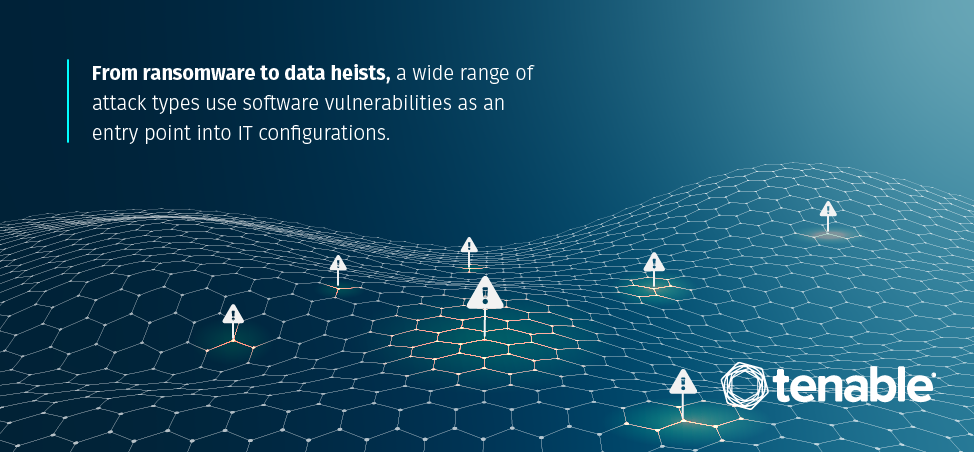Identifying software vulnerabilities is essential in protecting your business against cybersecurity threats. From ransomware to data heists, a wide range of attack types use software vulnerabilities as an entry point into IT configurations.
Dealing with security vulnerabilities requires identifying them in the first place. Before you can start to develop strategies for identifying weak points in your configuration, it’s important to first assess the different types of weak points that commonly emerge and how you can stay on top of them.

Common large-scale vulnerabilities (and how to deal with them)
There’s a great deal that can go wrong with software, giving attackers an opportunity to access data or get into your network. A few of the most common vulnerabilities include:
Zero-day threats
These are often the most challenging of the common vulnerabilities to deal with, but the good news is that it isn’t up to you to discover zero-day threats. These vulnerabilities are exploitable problems within an application or software system that can be used to penetrate a network or access data a person isn’t permitted to retrieve.
While this is typical to most software vulnerabilities, a zero-day threat is unique because it is not yet fully understood. A zero-day vulnerability is a weak point in an asset that has just been discovered by the security community. Attackers may already be exploiting it or could be capable of using it before security teams have a chance to resolve the issue.
The challenge comes when a zero-day threat is a software vulnerability that requires an update or patch to address. In these instances, you need to wait for the software provider to solve the problem and release an update. Then, you have to patch the vulnerability before attackers recognize the weakness and take advantage of it.
Working with cybersecurity providers that identify zero-day threats, alert you to the weaknesses, and provide guidance on the risk level can help you make an informed decision about how to deal with the problem.
Bugs/glitches
In the case of bugs or glitches, the software performs a behavior different than what it is meant to do when a user takes an action. This can happen because of problems in the code that cause a different action to be completed than what is indicated in the user interface. Problems with code can be difficult to identify, especially as individuals trying to fix them need to replicate the specific actions a user took prior to experiencing the bug to confirm the problem.
Vulnerability scanners are critical in addressing bugs and glitches because they can analyze assets to identify flaws.
Configuration errors
Software can become vulnerable if it is misconfigured. For example, if a database is designed to follow a specific workflow to publish data to an internal server where users can access it, but an infrastructure change alters the port setup on host systems, it may incorrectly attach that database to a public website. In this case, the software becomes a point of vulnerability because it is sending data to a place that compromises its security.
This is another area where penetration testing and vulnerability assessment solutions are vital. These technologies can automatically track how data moves between systems when used by software and recognize when a problem arises. Nessus accomplishes this task by supporting specific configuration scans based on industry-standard benchmarks such as Center for Internet Security (CIS), Defense Information Systems Agency (DISA) and similar compliance benchmarks.
Discovering and isolating specific vulnerabilities
Other flaws are much more specific to particular aspects of your IT infrastructure. However, the damage they can cause makes them loom large:
SQL and OS command injection vulnerabilities
Lines of SQL code and OS commands exist to tell an application where to move information or when to trigger a specific action. When vulnerabilities exist in these codes, attackers can inject replacement code into the system, telling the application to reroute data to the attacker or take a specific action counter to the base programming.
Vulnerability scanners will identify SQL or OS command injection vulnerabilities in the same way they handle most bugs or glitches.
Buffer overflow
Applications are typically designed with a buffer that allows for a certain amount of data to be stored in a cached format. This attack overloads that buffer, causing data to be lost or stolen, and potentially compromising the system.
Dealing with buffer overflow vulnerabilities is a matter of identifying the compromised code causing the issue and resolving it. Using a vulnerability assessment solution that can analyze the software for you will make the process much easier.
Vulnerability assessment is essential for cybersecurity
The wide range of vulnerability types – not to mention the diverse ways attackers can target them – make vulnerability assessment a critical component of any cybersecurity practice. Continually assessing your network for security vulnerabilities can help you with everything from preventing unauthorized access to applications to identifying underlying software flaws that expose sensitive data.
Vulnerability scanners help you identify flaws or weaknesses, making it easier to figure out if your systems have common vulnerabilities or rare flaws that need to be addressed. Either way, consistent vulnerability assessments promote stronger security and help you get ahead of zero-day threats.
Tenable is committed to advancing vulnerability assessments. We have identified more than 100 zero-day threats in the last year and release new plugins to provide key information on vulnerabilities within 24 hours of their disclosure.
With Nessus, you can gain control over your software systems and identify security weaknesses and flaws quickly – so you can address issues before attackers can take advantage of these vulnerabilities.
With industry-leading vulnerability assessment capabilities available, Tenable can help you take your cybersecurity to the next level.
Source: Tenable

